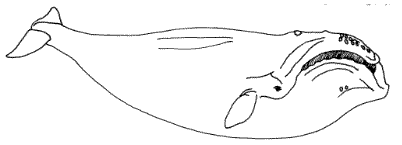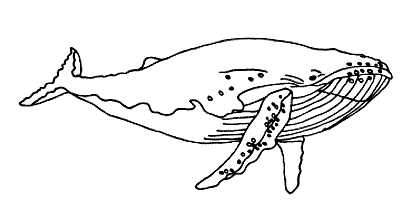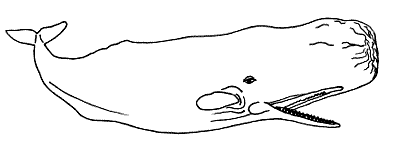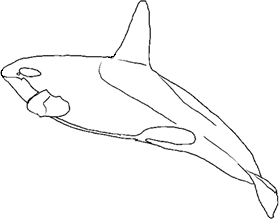Whale Species in Antarctica
Types of Whales
Whales are not only the largest animals alive today, they are the largest animals to have ever lived. Hunted to the edge of extinction, they are making something of a comeback, though some species are recovering more quickly than others.
Blue
Whale
Sulphur Bottom Whale - Sibbald's
Rorqual
Balaenoptera musculus
Average adult length 25m (males) 26.2
m (females).
Average adult body weight 100 -120 tonnes.
A baleen whale.
The largest animals ever to have lived, dwarfing even the largest dinosaurs, all figures about blue whales are awesome. Their circulatory system pumps 10 tonnes of blood through its body using a heart the size of a small car. A child could crawl down the whales' main blood vessel, the aorta. In its development, a blue whale calf can drink 50 gallons of its mother's milk and gain 200lbs per day!
The largest individuals have been estimated at being 150-200 tonnes.
Blue whales are light grey/blue to dark grey while at the surface, but seen underwater they are a luminous aqua blue.
Southern Right Whale
Balaena glacialis
Average adult length 20m.
Average
adult mass unknown, maximum of 96 tonnes.
A baleen
whale.
The name was given by the early whalers because they were the "right" whales to kill. They have large amounts of oil, blubber and baleen or whalebone, they are slow swimming (easy to catch), are often found close to shore and float when killed.
Right whales have a large bulbous head and lack the streamlined shape of other whales. The head has large callosities that are home to a whole colony of whale barnacles, parasitic worms and whale lice.
Sei Whale
Balaenoptera borealis
Average adult body length 16m.
Average body mass 13 tonnes.
A baleen whale.
These are among the more elusive of the larger whales, not coming very close to land at any time and not forming large groups or "schools". Sei is pronounced "Say"
They are found like many whales in both Northern and Southern hemispheres following the best feeding at different times of year. Only the larger older individuals tend to go very far south, they are relatively rare in Antarctica.
Humpback Whale
Megaptera novaeangliae
Average adult body length:
12.9
m (males) 13.7 m (females).
Average weight:
25
- 35 tonnes, maximum of around 48 tonnes.
A baleen
whale.
So called because of the habit of raising and bending the back in preparation for a dive, accentuating the hump in front of the dorsal fin.
Probably the best known of the large whales as they often collect in groups near to land and draw attention to themselves by their behaviour. Breaching, lob-tailing and flipper-slap are common and often occur several times in a row.
They are slow swimmers (allows tourist boats - and whalers - to get close). Males at breeding time sing the longest and most complex songs in the animal kingdom.
Antarctic Minke whale
Balaenoptera bonaerensis
Average adult length 9m.
Average
adult body weight 7 tonnes.
A baleen whale.
One of the smallest baleen or filter feeding whales. Minke numbers are still quite healthy due to whalers concentrating on larger, more profitable species.
Minkes are still hunted for "scientific" reasons by Japan, and large quantities of the meat turns up in expensive restaurants.
Minke whales

.webp)
Fin whale
Balaenoptera
physalus
Average adult body length 20m.
Average adult body mass 50 tonnes.
A baleen whale.
The second largest after the blue whale, the fastest swimming of all the large whales (sometimes called the greyhound of the seas) and the commonest large whale.
Fin whales can produce sounds of 75-80dB at around 100Hz which is very loud for an animal source. In pre-propeller oceans this sound could travel for well over a hundred kilometres.
Sperm whale
Physeter macrocephalus
Average adult body length 16m.
Average adult body mass 35 tonnes.
A toothed whale.
The name comes from the enormous bulbous spermaceti organ in the head.
Only males are found in Antarctic waters. Sperm whales are toothed whales rather than filter feeders and are the deepest and longest of all whale divers catching giant squid in the dark ocean depths.
Unlike baleen whales, which form only temporary bonds, sperm whales live in extended family units that for the females are lifelong associations.
Killer Whale - Orca
Orcinus orca
Average adult body length males 9-10m,
females 4.5-6m.
Adult weight: males 11.1 tonnes max.
females 8.3 tonnes max.
A toothed whale.
Also known as Orcas from their Latin name. They are one of the most well known types of whales thanks to their being held captive in marine aquariums where they are taught to perform tricks.
Killer whales are toothed whales and top carnivores in their food chain. Sometimes referred to as "sea-wolves", they frequently hunt in packs or "pods". Their tastes are wide ranging from krill and fish to penguins, seals and even much larger baleen whales.
Whale statistics - these are very variable. If you do any research on whales on the internet, or in books, you will find that there are wide differences in the recorded length and mass of the various species. Lengths are generally more reliable than weights as it easier to measure the length of a whale, from whalers records or from photographs against objects of known size. The weight on the other hand is very difficult to measure and is often based on some rough measurements and estimates from those measurements of whales caught by whalers.
Unlike other animals it is not possible to guide a whale onto a weigh bridge or to suspend it from a crane to measure the weight (or even take it to the whale-weigh station, arf!). The only time whales have been available in quantity for such statistics was during the old whaling days and then it was most important to get them processed as quickly as possible before the next one arrived, so weights are educated guesses at best.
As well as the species detailed here, there are also some other smaller and rarer species of Antarctic whales such as the Southern Bottlenose whale (up to 9.75m long), Arnoux's beaked whale (to 7.5m) and the southern hourglass dolphin, the smallest Cetacean in Antarctic waters at 1.5-2m long.

A comparison of the size of baleen
whales,
the bowhead and grey whales are not species found
in Antarctica
Picture courtesy
- The Lord of the Allosaurs
Picture credits: Most pictures courtesy of NOAA except - Fin whale off the coast of Greenland, Aqqa Rosing-Asvid - Visit Greenland Creative commons 2.0 generic license / Sperm whales off the coast of Mauritius, Gabriel Barathieu - Creative Commons Attribution-Share Alike 2.0 license /














